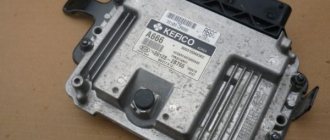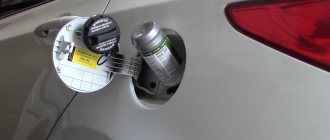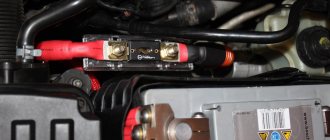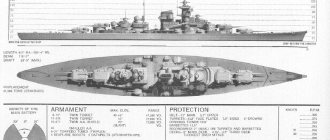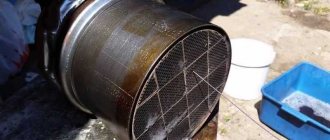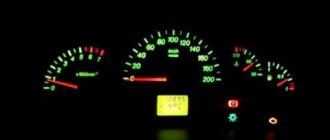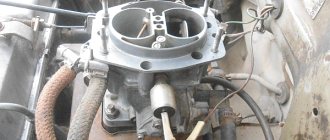Causes and symptoms of water in the fuel tank
Water in gasoline makes it difficult to start the power unit, therefore, if the engine “trips” or is unstable during the morning start, you should check the fuel for the presence of foreign impurities. As the cooling system warms up, the symptoms disappear as water begins to evaporate upon contact with heated parts. But when trying to accelerate sharply, drops in speed begin to be observed again (even to the point of stopping the engine).
The water accumulating in the fuel line freezes (especially when driving due to the flow of cold air blowing through the pipes), cutting off the fuel supply. The absence of gasoline in the pump cavity (on carburetor engines) or in the injectors (on diesel engines and engines with distributed injection) is a sign of water entering the tank. Restarting the unit is possible only after removing the ice plug from the fuel supply pipes.
Why does water get into the tank?
Moisture often gets into the gas tank during the cold season, when a small amount of fuel is often poured into the tank. Due to temperature changes, condensation forms, which then turns into water. The amount of such moisture over the entire season is usually small, but it does not bring anything good to the engine and reduces power by several percent.
Another way water gets into the fuel system is low-quality gasoline. Unscrupulous manufacturers may allow its presence in fuel. The amount of moisture in such cases is small, but, as in the previous case, such low-quality fuel will not bring anything but problems. Therefore, it is extremely important to refuel at trusted places that sell high-quality gasoline.
A common reason for water getting into the gas tank is the formation of condensation.
How can moisture harm the fuel system?
Water entering the lines leads to corrosion of steel elements and disruption of the relative position of parts in the injection system. Frozen water in the lines leads to rupture of the outer wall or damage to the sealing rings. Negative consequences include fuel leaking through damaged lines, which leads to a fire.
Solidification of the fuel-water mixture has equally negative effects on spark-ignition engines and compression-ignition engines.
Freezing water in the gas tank and solutions to the problem
The water-based liquid that has accumulated at the bottom of the reservoir freezes, blocking the fuel supply line or jamming the pump that pumps fuel into the injection system. Repeated attempts to start the power unit lead to battery discharge and damage to the fuel system injectors. To clean, you need to remove the module, which is attached with screws to the top of the container. It is possible to place the machine in a heated room, and then remove impurities from the tank mechanically or using special means.
If the water in the gas tank is frozen
If the water in the tank has turned to ice, then the best option would be to warm up the car in a warm garage. After making sure that the pieces of ice in the tank have turned into water, you should use one of the methods given above to remove it.
Video: water in the gas tank
There are many ways to get rid of water in the tank. But still, it is better not to solve this problem, but to avoid its occurrence with the help of simple prevention. If everything is done correctly, then you can forget about moisture in the tank for a long time.
Flushing the gas tank with your own hands: means, techniques, recommendations
Do-it-yourself repair and replacement of the gas tank cap
How to protect the tank from condensation?
Methods to reduce the likelihood of foreign liquids appearing in the fuel tank of a car:
- refuel at large gas stations owned by oil companies;
- Avoid partially filling the tank in the rain or during heavy fog;
- when storing a car outdoors, it is necessary to fill the fuel tank to the maximum;
- before the start of the winter season, remove residual moisture (accumulated during the summer and autumn) with special displacers or alcohol;
- use a tank lid with a lock that prevents attackers from draining fuel and pouring aqueous solutions into the tank;
- monitor the condition of the lid, since rainwater enters the tank through cracks and condensation penetrates.
Ways to prevent water from entering the gas tank
In any case, it will not be possible to completely remove water from the gas tank. However, you can reduce the likelihood of it getting into the tank using the following recommendations:
- do not refuel at unfamiliar gas stations;
- do not open the gas tank filler cap often - get rid of the habit of refueling with a small amount of fuel;
- in humid weather, fill a full tank of gasoline, due to which the water is completely displaced from the container;
- in the fall, add about 200 grams of alcohol or special additives to the tank;
- change the fuel filter promptly;
- Every autumn, empty and then dry the gas tank well and fill with the maximum amount of fuel;
- Install a lid with a complex lock on the tank neck.
Freezing water in the gas tank and solutions to the problem
In winter, water that gets into the gas tank freezes. This is quite dangerous. Pieces of ice begin to block the flow of fuel into the system. This may cause the fuel pump to fail. Even if the car starts, the engine will run unevenly, with dips. This will be especially noticeable when driving uphill.
Frozen water in fuel can quickly damage a car.
If water accidentally gets into the fuel line, it will freeze in winter. Gasoline will not flow into the engine and the car will not start. Since water expands when it freezes, the injector nozzles may be destroyed and the injection system will stop working. In addition, repeated attempts to start the engine in winter can drain the battery or damage the fuel pump. In this case, you need to drive the car into a warm garage or remove the gas tank and melt the ice with a stream of warm, dry air.
More or less water is present in any fuel tank. The main thing is to promptly recognize the signs of the negative impact of moisture on the car. Preventive measures, including the use of high-quality fuel, are of great importance.
Methods for removing water from the system
Before getting rid of water in the gas tank, you should decide on the method of performing the work. On older cars, it is more advisable to dismantle the fuel tank, and then rinse and dry the container. In addition to removing foreign impurities, rust that clogs the fuel supply pipes and jets in the carburetor is removed from the reservoir.
Filling with special liquids that remove water from the fuel speeds up the cleaning procedure. When using reagents, the possible negative impact of the components on the catalytic converter should be taken into account. Before pouring the liquid, you must study the instructions and make sure that the solution can be used in the car.
Mechanical removal of water from the gas tank
To clean the container from traces of moisture, you will need to dismantle the unit (or drain the sediment through a special plug used on some car models). If the tank is located inside the luggage compartment, you will need to remove the metal fastening straps and disconnect the fuel supply and return lines. Then the gasoline is drained from the tank, the container is washed, dried and installed in its original place.
When draining the tank, do not use open flame heaters (due to the risk of ignition and explosion of fuel vapors).
Tanks located under the bottom of the car are more difficult to dismantle. To remove the reservoir, you will need to remove the exhaust pipe and dismantle some of the rear suspension parts. To clean tanks, liquid is pumped out using a hose lowered into the container. The opposite end of the tube is placed below the fuel level in the tank. To speed up the draining procedure, it is recommended to drive the car onto a lift or overpass. The disadvantage of this method is the residual liquid that remains at the bottom of the tank.
It is possible to remove water from the gas tank using a standard electric pump used to supply fuel to the rail on machines with distributed injection. The line is disconnected from the ramp, the free end is lowered into an empty tank of suitable capacity. Then the ignition is turned on (or the pump is turned on via the diagnostic connector by the test computer), the pump pumps liquid into the substituted reservoir. After the procedure, the remainder of the fuel mixture remains in the car tank (in hidden cavities).
Removing water using special means
Pouring special agents into the tank allows you to form a solution of water and a reagent, which is then evenly distributed in the fuel. The resulting mixture is stable and does not separate into fractions during storage (according to density or other physical characteristics). The fuel pump pumps the mixture into the carburetor or supplies it to the cylinders through the injectors. Then the substances burn without consequences for engine parts and the exhaust gas aftertreatment system.
Use of additives
There are special additives added to fuel to remove carbon deposits on parts of the cylinder-piston group. The substances are capable of dissolving aqueous solutions in themselves, the resulting mixture then burns in the engine cylinders. Additives do not leave carbon deposits after combustion that can damage rubbing surfaces.
How to remove water from the system?
To prevent such a turn of events, a dehumidifier for the fuel system was invented. It acts by displacing moisture, being, in fact, a dehydrator, and serves as a fuel additive. It also contains some cleaning additives that keep the system clean and prevent corrosion of parts.
You can use isopropyl alcohol
There is another old, proven folk method of removing water. Ordinary alcohol is poured into the tank, which also copes well with moisture. Isopropyl alcohol is suitable for this role. It can be found in a hardware store next to solvents, acetones and white spirits. A 300 ml bottle will cost about 60 rubles. If the volume of your car's gas tank is from 40 to 50 liters, then you will need 0.5 liters of alcohol for a full tank of gasoline or diesel fuel. If the tank is more than 50 liters, then you need to pour in 0.6 liters of IPA. The whole procedure will cost you about 100 rubles. Alcohol will not cause any harm to the engine or fuel line parts, but the desired effect will certainly be achieved. It will burn along with excess water and fuel, having done its job. Alcohol has long proven itself well as a dehumidifier not only in the automotive industry, but also in solving problems with other equipment.
Popular dehumidifiers
To remove moisture from fuel, special liquids or organic solvents for oil-based paints are used. It is allowed to use methyl or ethyl alcohol, which binds water into a solution that mixes evenly with gasoline or diesel fuel. Special reagents have an increased cost; they contain additional additives that improve the operating conditions of the power unit.
Alcohol, acetone and solvent
Pouring 0.3-0.5 liters of pure ethyl alcohol into the tank allows you to dissolve traces of moisture in gasoline. The resulting water-alcohol solution has a density comparable to the characteristics of gasoline. The mixture is then supplied to the engine cylinders and burned without harming the fuel supply equipment. The advantage of using alcohol is the high octane number of the substance (98-100), which does not lead to detonation. The disadvantage of the method is the lack of alcohol in the public market.
Instead of alcohol, acetone or solvent can be used. The advantages of the technique include the availability and low price of reagents. The disadvantage is the possible destruction of the rubber o-rings and damage to the surface of the plastic fuel tank. Solvent has a low octane number, which worsens the characteristics of gasoline filled into the tank. But the effect, given the ratio of liquids in the solution, is insignificant.
To remove moisture from the gas tank of cars equipped with a compression ignition engine (diesel), machine oil is used (proportion of 0.5 liters of oil per 50 liters of fuel). The oil forms an emulsion with aqueous solutions, which is fed into the cylinder by nozzles and then burns. The technique is not intended for diesel engines with electronic pump injectors, which become clogged and damaged by the emulsion.
Specialized moisture removers
Special gas tank dehumidifiers contain substances that bind water-based solutions. The reagent is used at low ambient temperatures, preventing the mixture of fuel and foreign liquid from freezing. Liquids are produced both by oil refining companies (Shell BT90l) and by manufacturers of motor oils or special products for cars (Wynns Dry Fuel, XADO Aquastop XB 40080, etc.).
For example, Fuel Protect (manufactured by Liqui Moly) comes in a 0.3 ml bottle. The capacity of the can is enough to dry 60 liters of gasoline (the substance is not used for diesel engines), the reagent is poured into a partially filled tank (to ensure mixing of liquids). The manufacturer recommends administering the solution for preventive purposes (at an ambient temperature of 0°C). The fluid contains special additives that protect the fuel system from corrosion.
The special fuel dryer is manufactured by Hi-Gear. The components included in the solution do not have a negative effect on catalytic converters and oxygen sensors. The reagent can only be used for gasoline engines (atmospheric and equipped with compressors).
The universal solution Universal Winter Fuel Dryer from Lavr is designed to remove moisture from gasoline and diesel fuel. The reagent is refilled after 2-3 tank fills or when traces of water are detected in the tank. One can of solution is enough to drain a tank with a capacity of up to 60 liters. If the trapped water is frozen, the substance will not be able to remove the ice. The car must be towed to a heated parking lot, and then the reagent must be filled into the tank.
How to detect water in a gas tank
For obvious reasons, the driver will not be able to look into the car’s gas tank and properly examine its contents. It is possible to understand that water has entered the tank only by a number of indirect signs.
You can see the water in the tank of a VAZ 2110 only by completely removing the tank
Main signs of water in the gas tank
We list the most common symptoms indicating moisture in the fuel tank of a car:
- the car won't start. This happens especially often in the morning, when the car owner tries to start an engine that has been sitting all night. During this time, moisture has time to penetrate the fuel line. From there it enters the fuel rail and injectors. Since the moisture sprayed by the injectors cannot ignite, starting the engine is impossible;
- engine malfunctions. The engine speed suddenly begins to “float”, and noticeable power drops periodically occur. This usually happens after pouring low-quality gasoline mixed with water;
- Gasoline leaks on the engine and under the car. Most often, this picture is observed at sub-zero temperatures. The reason is simple: moisture, having penetrated the car’s fuel line, freezes in it, and the resulting ice ruptures the pipes. Cracks form in the fuel line, through which gasoline leaks.

